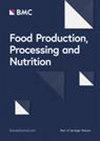生活在马拉维农村地区的学龄儿童对地方橙色玉米(MW5021)食品的维生素原A保留和感官接受度
IF 5.7
3区 农林科学
Q2 FOOD SCIENCE & TECHNOLOGY
引用次数: 0
摘要
摘要:长白橙玉米富含类胡萝卜素,被认为是维生素a缺乏症的潜在可持续解决方案。本研究评估了马拉维农村学龄儿童对地方橙色玉米食品的接受程度。它还测定了维生素原A类胡萝卜素在不受控制的环境中储存、碾磨和烹饪后的保留率。采用7分快乐量表对学龄儿童(n = 160)进行粥和浓粥的感官评价。采用分光光度法分析食品中总类胡萝卜素含量(TCC),并采用高效液相色谱法(HPLC)鉴定食品中具体的类胡萝卜素成分。感官评价结果显示,与通常由白玉米制成的食品相比,地方橙色玉米食品的接受度更高。橙玉米和白玉米的素粥得分分别为6.5±1.4和5.6±1.9。用nsima观察到类似的结果。橙色玉米nsima评分为6.8±0.7分,白色玉米评分为5.8±1.9分。经过10个月的贮藏和加工,总类胡萝卜素的保留率为89%,单个类胡萝卜素的保留率为59%。尽管β -胡萝卜素被完全降解,但β -隐黄质保留了42%,并具有维生素A原活性。鼓励地方橙玉米的生产似乎是为马拉维农民提供富含类胡萝卜素且高适口性食物的有效策略。它提供了一个具有成本效益的选择,以减少对补充和强化的依赖。图形抽象本文章由计算机程序翻译,如有差异,请以英文原文为准。
Provitamin A retention and sensory acceptability of landrace orange maize (MW5021) food products among school-aged children living in rural Malawi
Abstract Landrace orange maize is rich in carotenoids and is thought to be a potentially sustainable solution for Vitamin A deficiency. This study evaluated the acceptability of landrace orange maize food products among school-aged children living in rural Malawi. It also determined the retention of provitamin A carotenoids after storage in an uncontrolled environment, followed by milling and cooking. Sensory evaluations of porridge and nsima (thick porridge) were carried out in school-aged children ( n = 160) using a 7-point hedonic scale. Total carotenoid content (TCC) was analysed using a spectrophotometric method and High-Performance Liquid Chromatography (HPLC) was used to identify the specific carotenoid composition of the food products. Sensory evaluation results showed a higher acceptance of landrace orange maize food products in comparison to those commonly prepared from white maize. Plain porridge scored 6.5 ± 1.4 and 5.6 ± 1.9 for orange and white maize, respectively. Similar results were observed with nsima . Orange maize nsima received a score of 6.8 ± 0.7 while white maize was evaluated at 5.8 ± 1.9. After 10 months of storage and processing, there was 89% retention of total carotenoids with 59% accounted for by evaluation of individual carotenoids. Despite the total degradation of beta-carotene, 42% retention of beta-cryptoxanthin with provitamin A activity was observed. Encouraging the production of landrace orange maize appears to be a useful strategy for providing Malawian farmers with carotenoid-rich foods with high palatability. It presents a cost-effective option to reduce dependence on supplementation and fortification. Graphical Abstract
求助全文
通过发布文献求助,成功后即可免费获取论文全文。
去求助
来源期刊

Food Production, Processing and Nutrition
Medicine-Public Health, Environmental and Occupational Health
CiteScore
6.90
自引率
4.30%
发文量
28
审稿时长
12 weeks
 求助内容:
求助内容: 应助结果提醒方式:
应助结果提醒方式:


